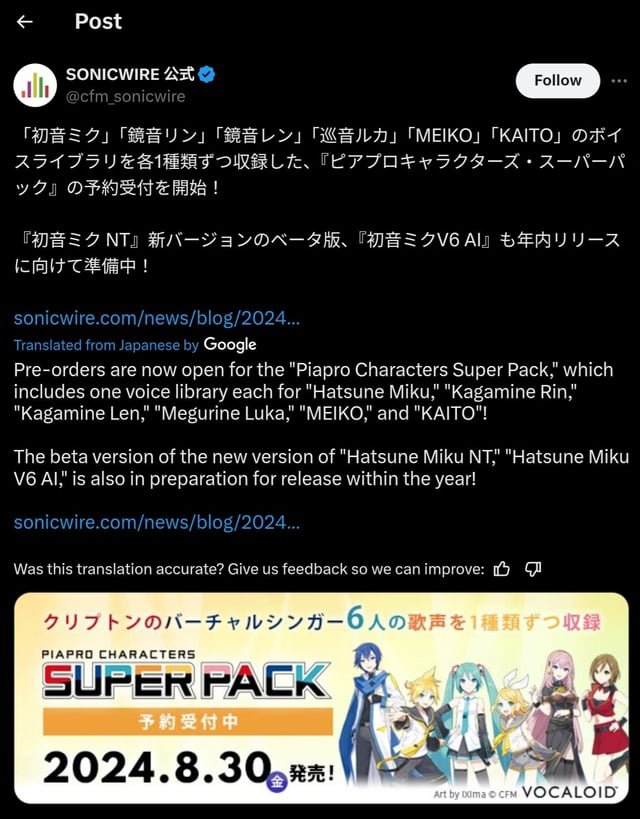Writing lyrics for Vocaloid songs can be a fun and creative process. It lets you express yourself through music in unique ways.
For beginners, crafting lyrics for Vocaloid can seem daunting. With so many options for voice and style, where do you start? This guide aims to simplify the process. You will learn basic techniques to write engaging and meaningful lyrics. Whether you're into pop, rock, or electronic music, this guide will help you get started.
By the end, you’ll be ready to create lyrics that suit any Vocaloid voice. Let's dive in and explore the exciting world of Vocaloid song lyrics!

Credit: www.youtube.com
Introduction To Vocaloid
Writing lyrics for Vocaloid songs is a unique and creative process. Vocaloid offers endless possibilities for music enthusiasts. In this guide, we will introduce you to the world of Vocaloid and its fascinating characters.
What Is Vocaloid?
Vocaloid is a voice synthesis technology developed by Yamaha. It allows users to create songs using virtual singers. These virtual singers are known as Vocaloids. They can sing lyrics in various languages, including English, Japanese, and Chinese. The software synthesizes the human voice by combining recorded samples with user-defined lyrics and melodies. This technology opens up new avenues for songwriters and producers. It is especially popular in the Japanese music industry.
Popular Vocaloid Characters
Vocaloid features many popular characters. Each character has a unique voice and personality. Here are some of the most well-known Vocaloids:
- Hatsune Miku: The most iconic Vocaloid. She is known for her high-pitched, energetic voice.
- Kagamine Rin and Len: Twin Vocaloids with complementary voices. Rin has a bright voice, while Len has a slightly deeper tone.
- Megurine Luka: Known for her mature and smooth voice. Luka can sing in both Japanese and English.
- Kaito: One of the first male Vocaloids. He has a rich and warm voice.
- Meiko: Another early Vocaloid. Meiko has a strong and versatile voice.
These characters have their own fan bases. They often appear in concerts and other media. Understanding their unique voices can help you write better lyrics for them.
Getting Started With Lyrics
Starting your journey in writing lyrics for Vocaloid songs can be exciting. Focus on themes and emotions to create engaging content. Keep your lyrics simple and easy to follow for the best results.
Writing lyrics for Vocaloid songs can be a fun and exciting journey. It allows you to express your creativity and share stories through music. Before you begin, it's important to have a clear idea of what you want to achieve. This section will guide you through the initial steps of writing lyrics for Vocaloid songs.Finding Inspiration
Inspiration can come from many places. Listen to different genres of music to see what resonates with you. Pay attention to the lyrics and emotions they convey. You can also draw inspiration from movies, books, or personal experiences. Keep a notebook handy to jot down ideas whenever they strike.Choosing A Theme
Once you have some inspiration, decide on a theme for your song. A theme gives your lyrics direction and coherence. It could be about love, friendship, dreams, or even fantasy worlds. Think about what you want your audience to feel or understand through your song. A clear theme will make your lyrics more impactful and relatable. “`Understanding Vocaloid Voices
Writing lyrics for Vocaloid songs can be fun and rewarding. Vocaloid voices are unique and versatile, allowing for creative freedom. Beginners should focus on simple, catchy phrases to match the synthetic voices.
Writing lyrics for Vocaloid songs can be a fun experience. Vocaloid voices are unique and diverse, and understanding them is key. Each Vocaloid has its own characteristics, which can influence your lyrics. Let's explore these voices and how to match your lyrics to them.Voice Characteristics
Vocaloid voices come in many different tones. Some are soft and sweet, while others are strong and powerful. Each voice has a specific range and timbre. This affects how the lyrics will sound when sung. For example, Miku Hatsune has a clear, high-pitched voice. Luka Megurine, on the other hand, has a deeper, more mature tone. Know your Vocaloid’s voice before you start writing.Matching Lyrics To Voice
To write effective lyrics, match them to the Vocaloid's voice. Consider the voice’s range. Avoid lyrics that require notes too high or too low for the voice. The tone of the voice also matters. Sweet voices suit gentle, emotional lyrics. Strong voices work well with powerful, energetic words. Think about the voice’s personality. Match the lyrics to the character’s style and image. This will make your song more cohesive and engaging. “`Structuring Your Song
Structuring your song is crucial for creating a compelling Vocaloid track. A well-structured song keeps the listener engaged and makes the lyrics memorable. Let's delve into the essential components of song structure to help you craft your own Vocaloid masterpiece.
Verses And Choruses
The verse is where you tell the story of your song. It sets the scene and introduces the characters or themes. Verses should be clear and concise, providing context for the chorus.
The chorus is the heart of your song. It's the part that listeners will remember. It usually contains the main message or emotion of the track. Choruses are often repeated, making them catchy and impactful.
Bridges And Breakdowns
The bridge offers a change of pace. It provides contrast to the verses and choruses. This section can introduce a new perspective or shift in the story.
Breakdowns add variety and keep the listener interested. They can be instrumental or lyrical, giving the song a dynamic feel. Breakdowns often lead back into the final chorus, creating a powerful conclusion.
Writing Engaging Lyrics
Creating Vocaloid song lyrics is a fun way to express creativity. Start with a catchy theme or story. Use simple, relatable words to connect with listeners.
Writing engaging lyrics for Vocaloid songs can be a fun experience. Vivid imagery and figurative language are key to capturing your audience's attention. Below are some tips on how to achieve that.Creating Vivid Imagery
Vivid imagery helps listeners visualize the story you are telling. Use specific details and sensory words to paint a picture in their minds. For example:- Instead of saying “It was a nice day,” say “The sun shone brightly, warming the green grass.”
- Describe emotions with physical sensations, like “Her heart pounded like a drum.”
| Original | Vivid |
|---|---|
| The room was messy. | Clothes and books were scattered across the floor like fallen leaves. |
| She felt happy. | She grinned ear to ear, her eyes sparkling with joy. |
Using Metaphors And Similes
Metaphors and similes create connections between ideas. They make your lyrics more interesting. A metaphor directly compares two things, while a simile uses “like” or “as”. Here are some examples:- Metaphor: “Life is a journey with winding roads.”
- Simile: “Her smile was as bright as the sun.”
Examples:
- Metaphor: “Love is a battlefield.”
- Simile: “He sang like a nightingale.”
Adapting Lyrics For Vocaloid
Writing lyrics for Vocaloid songs can be a fun and creative process. However, it requires a unique approach. Adapting lyrics for Vocaloid involves paying close attention to syllable count and pronunciation. This ensures the Vocaloid sings your lyrics clearly and accurately. In this section, we will discuss some key tips to help you adapt your lyrics for Vocaloid.
Syllable Count
One of the most important aspects of adapting lyrics for Vocaloid is the syllable count. Each Vocaloid voicebank works best with a specific number of syllables per line. Matching the syllable count to the music is crucial. This ensures a smooth and natural vocal performance.
Here are some tips to manage syllable count:
- Count the syllables in each line of your lyrics.
- Adjust the lyrics by adding or removing words.
- Use short words to fit more syllables into a line.
- Split longer words into multiple syllables if needed.
For example, if your music line has eight beats, make sure your lyrics have eight syllables. This helps the Vocaloid to sing each word clearly.
Pronunciation Tips
Pronunciation is another key factor in adapting lyrics for Vocaloid. Vocaloid singers need clear and precise pronunciation to sound natural. Different Vocaloid voicebanks may have different pronunciation quirks. Pay attention to these while writing your lyrics.
Here are some pronunciation tips:
- Avoid complex words that might be hard to pronounce.
- Use phonetic spelling for tricky words.
- Test the pronunciation using Vocaloid software.
- Listen to native speakers for accurate pronunciation.
Using phonetic spelling is very helpful. For instance, if the word “night” does not sound clear, you can use “nait” instead. This ensures the Vocaloid sings the word correctly.
By focusing on syllable count and pronunciation, you can create clear and engaging lyrics for your Vocaloid songs. Remember to test and adjust your lyrics as needed. Happy songwriting!
Common Mistakes To Avoid
Writing lyrics for Vocaloid songs can be a rewarding experience. Yet, many beginners make common mistakes that can detract from their work. Understanding these pitfalls can help you create better songs and enjoy the process more.
Overcomplicating Lyrics
Many beginners try to use complicated words and phrases. This can make the song hard to sing and understand. Keep your lyrics simple and clear. Use words that are easy to pronounce. Avoid long and complex sentences. This will make your song more enjoyable for listeners.
Ignoring Vocaloid's Range
Each Vocaloid has a unique vocal range. Ignoring this can result in poor sound quality. Make sure your lyrics fit within the Vocaloid's range. Test your lyrics with the software. This helps ensure that the song sounds good. Remember, a Vocaloid's range is not as flexible as a human's.

Credit: www.tiktok.com
Polishing Your Lyrics
Creating lyrics for Vocaloid songs can be a thrilling experience. But, it doesn't stop at writing. Polishing your lyrics is crucial. This step ensures your words flow well and convey the right emotions. Let's dive into the essentials of editing and revising, and seeking feedback.
Editing And Revising
Editing and revising are key stages in lyric writing. Start by reading your lyrics aloud. This helps spot awkward phrases and rhythm issues. Make sure your lyrics match the melody. Adjust words to better fit the music.
- Check for consistency in your theme.
- Ensure each line serves a purpose.
- Look out for grammatical errors.
Use tools like rhyme dictionaries and thesauruses. These can help find better words. Remember, simplicity often works best. Avoid overcomplicating your lyrics.
Seeking Feedback
Feedback is invaluable for improving your lyrics. Share your work with friends or fellow musicians. They can offer fresh perspectives. Consider joining online forums or groups dedicated to Vocaloid music. These communities are full of helpful enthusiasts.
- Ask for specific feedback on your lyrics' flow and meaning.
- Be open to constructive criticism.
- Revise based on the feedback you receive.
Sometimes, stepping away from your lyrics for a while helps. Return with a fresh mind. You may spot areas needing improvement that you missed before.
Polishing your lyrics takes time and patience. Keep refining until you're satisfied. Your Vocaloid song will shine with well-crafted, polished lyrics.

Credit: www.tiktok.com
Frequently Asked Questions
How Do I Start Writing Lyrics For Vocaloid Songs?
Begin with a theme or story. Write simple, expressive lines. Use rhymes and rhythm. Keep practicing.
What Makes Vocaloid Lyrics Unique?
Vocaloid lyrics often feature futuristic themes, unique perspectives, and creative storytelling. They are tailored for synthetic voices.
How Do I Match Lyrics To Vocaloid Melodies?
Listen to the melody repeatedly. Write lyrics that fit the rhythm and mood. Adjust syllables for smooth flow.
Can Beginners Write Good Vocaloid Lyrics?
Yes, beginners can write good Vocaloid lyrics. Start simple, practice regularly, and seek feedback from the community.
Conclusion
Creating Vocaloid lyrics can be fun and rewarding. Start with simple themes. Build your skills by practicing regularly. Listen to popular Vocaloid songs for inspiration. Remember to keep your lyrics clear and concise. Share your work with others for feedback.
Keep learning and improving. Enjoy the creative process. Soon, you will see progress in your writing. Happy songwriting!









